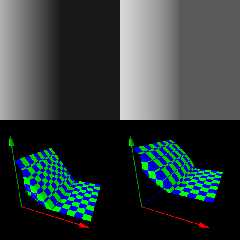|
 |
I'm not sure how to interpret this:
The first two images are renders of a cylinder in 3.6 (left)
and in 3.7 (right) using default settings and the following scene:
//+W1600 +H1600
light_source {-100*x color rgb 1 parallel}
#local w = 2;
camera {
orthographic
location -z*1E3
look_at y
right w*x
up w*y*image_height/image_width
}
cylinder {
0, w*y, w/2
pigment {color rgb 1}
}
The bottom row of images are height fields corresponding to the above two
images. Irrespective of the overall brightness (full shading in 3.7,
for example, is not totally black), one can see clearly that there is a
difference in the relative distribution of tones: 3.6 is a straight linear
gradient, 3.7 seems to be a partial parabolic curve.
I haven't done the math but this seems a straight-forward question for
anyone who knows more about the geometry of raytracing:
Is the reflection off a cylindrical surface, with parallel lights,
distributed along a straight line or a curve? If a curve, 3.7 seems more
accurate, though still not sure why full shadow isn't black.
Post a reply to this message
Attachments:
Download 'cylinder_3-6_3-7.png' (74 KB)
Preview of image 'cylinder_3-6_3-7.png'

|
 |




![]()